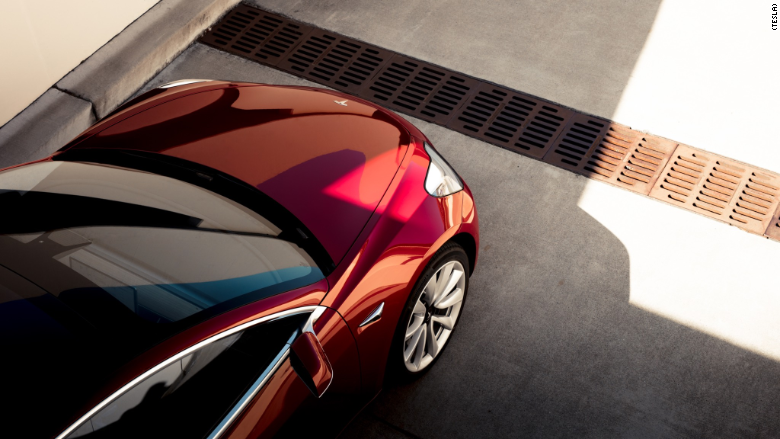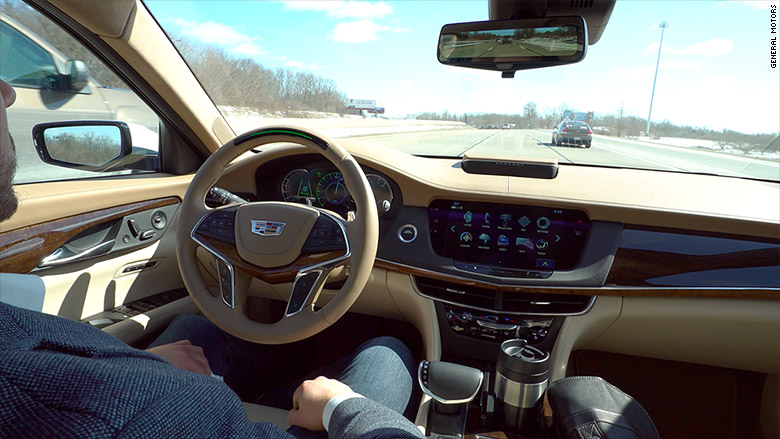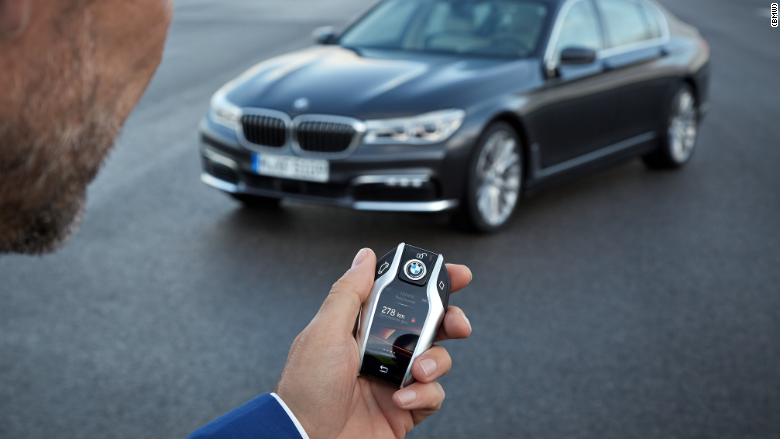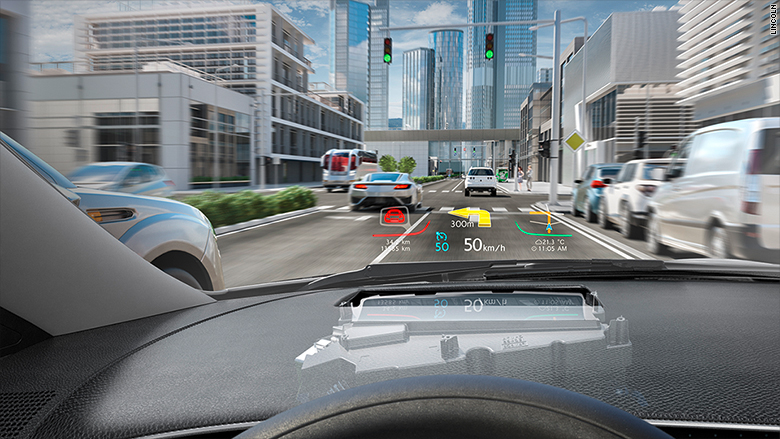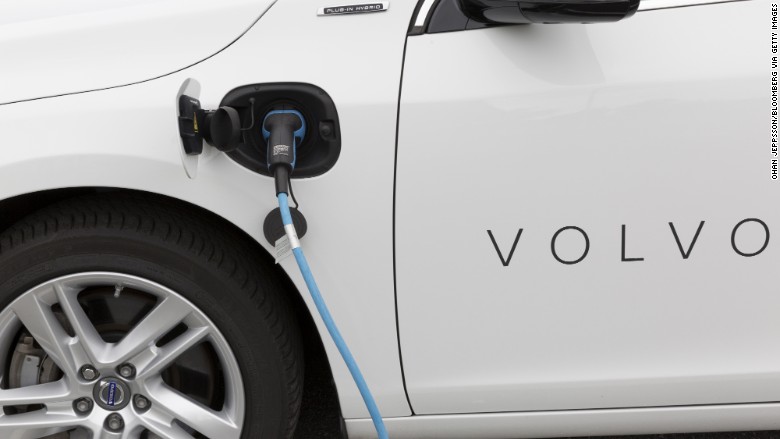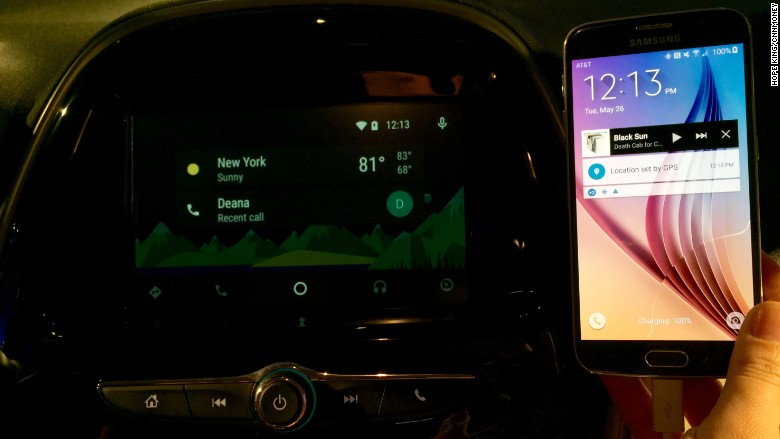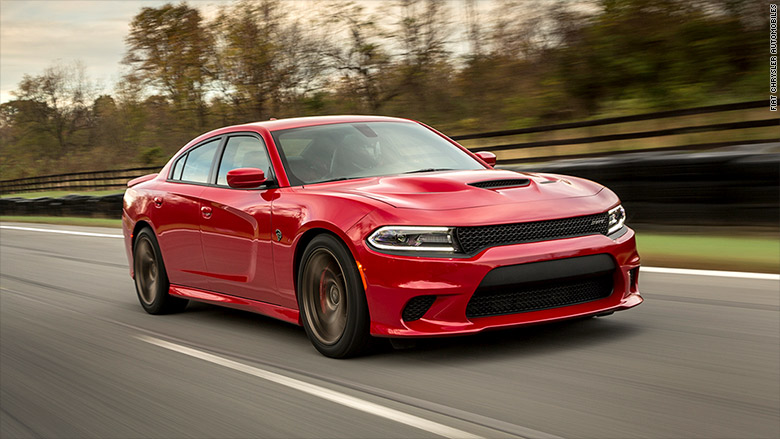1. Cars that ‘see’
Cars that fly or drive themselves aren’t available to the public yet, but many cutting-edge technologies are already featured in today’s vehicles.
More car companies are leaning on innovations coming out of Silicon Valley and elsewhere to make getting behind the wheel less of a hassle and more fun.
Here are some of the coolest features that tease the future of driving, from windshield projections to never needing to park again.
Cameras Galore
Humans are no longer the only ones to see the road ahead.
Cars are increasingly outfitted with sensors, especially cameras. With the help of computer vision software, cameras are able to identify signs — such as the speed limit — and adjust accordingly.
Ford offers a speed-limiting feature on several of its European cars, including the Kuga, Edge, S-Max and Galaxy. A driver in one of those vehicles can set parameters to prevent driving more than 5 mph above the speed limit. Rather than applying brakes to keep a driver at that speed, it limits the amount of fuel to the engine.
Cameras are also playing a big role in autonomous vehicles, such as helping them see around corners or detecting people and objects on the road.
Meanwhile, the Cadillac SuperCruise uses a camera on the steering column to monitor a driver’s eyes. It knows when a driver’s eyes turn away from the road for too long and flashes a light to help them re-focus.
2. Autonomous driving
Cars that drive on their own are a few years away. But some automakers are rolling out features that let motorists enjoy a small taste of the future.
Tesla’s Autopilot feature touts auto-steering and automatic emergency braking. On some roads, the vehicle can identify lane markers and steer to remain in the lane. If a driver doesn’t see a pedestrian or other obstacle, automatic emergency braking activates to stop the car.
The car is guided by eight cameras, 12 ultrasonic sensors and radar technology, often used on ships and planes, to locate the direction and distance of objects. High-end models from Mercedes-Benz, General Motors and Volvo offer similar systems.
Meanwhile, cars such as the Toyota Camry and Honda Civic currently feature adaptive cruise control, allowing them to automatically keep pace with the vehicle ahead of it.
The terms autonomous driving and self-driving are often used interchangeably. But there’s a scale of autonomy ranging from low-end features like cruise control to high-end vehicles that are so self-sufficient they don’t need steering wheels or pedals.
3. Parking assistance
Automakers want to eliminate the hassle of parking.
Although many companies offer a parallel parking function to guide drivers into spots, some manufacturers — including Tesla and BMW — are taking it a step farther. Automated parking doesn’t require a driver to be in the car.
The BMW 7 Series can be pulled in and out of tight spaces while the driver waits outside the vehicle. Drivers push a button on their key to instruct the car when to pull in or out of a parking spot.
Some Tesla cars can be summoned with a smartphone and slowly drive itself to meet its owner. The vehicles can also be synced with garage doors, so they can independently enter and exit while drivers wait outside.
4. Windshield displays
One solution to the danger of drivers taking their eyes off the road is a heads-up display, which project images onto windshields. This helps prevent drivers from looking away from the road to get information, such as navigation and speed.
The Lincoln Navigator offers a heads-up display so crisp it can be seen even if a driver is wearing polarized sunglasses. These displays have become a common option among luxury brands such as Jaguar, BMW and Audi.
5. Hybrid technology
You might expect hybrid cars to fade away as we move toward electric vehicles. But with more fuel economy demands, you’ll like see new hybrids hit the market in the years to come.
Many of these cars will be “mild hybrids,” which don’t boost efficiency as much as regular hybrids but cost less, thanks to smaller, less powerful batteries.
The batteries and electric motors in mild hybrids aren’t strong enough to move the weight of the car on their own but they provide some boost to the engine, allowing it to work efficiently and save fuel. As with other hybrids, batteries are charged from the gas engine directly or by recovering energy during braking.
The 2018 Jeep Wrangler will be available with a mild hybrid system like this.
On the other end of the spectrum, we’ll likely see more plug-in hybrids such as the Toyota Prius Prime. These cars use powerful batteries that can be charged from an external source and typically run on only electricity for a considerable distance.
6. A smartphone on wheels
More smartphone innovation is coming to cars. Apple CarPlay and Android Auto are increasingly common — the infotainment systems are now available on 600 car models. These services make it easy to do anything you’d do with your smartphone within the car, like access apps, make calls via voice assistants and get text messages read aloud.
A driver can also map a potential destination with a smartphone app before leaving the home, so you don’t have to type the address into the car’s computer. Meanwhile, CarPlay can predict where you may be driving by using addresses from your email and text messages.
The cost of these services vary by manufacturer.
7. Gasoline engine tech
Gas-powered engines are far more efficient than they’ve ever been. But even as electric cars seem nearly ready to replace gas engines, engineers are still finding ways to squeeze more from the 150-year-old technology.
Many automakers have been trying to perfect what’s known as Homogenous Charge Compression Ignition — a way of making gasoline engines behave like their efficient cousins, diesel engines.
Mazda engineers have designed one that uses air compression and is 30% more efficient. Although diesel engines ignite fuel without a spark plug, Mazda’s effort — due out in 2019 — sometimes uses one. That’s because it’s not always most efficient to use a compression ignition. Mazda’s engine works whichever way is best given the situation at any moment.
Meanwhile, engineers with Nissan’s luxury division Infiniti have developed an engine with variable compression by giving the piston, which compresses the air, variable range of movement.
When combined with turbocharging, which uses small turbines to force more air into the engine, it promises super-fast performance with better fuel economy.
8. Launch control
You may think quickly accelerating a car is as simple as mashing the gas pedal to the floor. But that would likely result in a lot of noise, back tires spinning out and you struggling to keep the wheels straight.
That’s why many high-performance cars — including the Dodge Challenger Demon, Ford GT, Acura NSX, and Lamborghini Aventador — have something called “Launch Control.”
The tech works by doling out as much power as possible until sensors detect if the wheels are losing their grip on the road. The system keeps power right on that knife-edge between maximum takeoff and out of control.
While you wouldn’t want to do this in a real driving situation, Launch Control is a way to have fun on an open track with the all that horsepower you purchased.



































